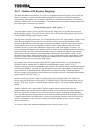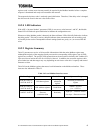
G7 ASD Multi-Protocol Communication Option and PG Feedback Option Manual
42
10.2.6 Programmable Pointer Registers
Modbus registers 0x0C00 ~ 0x0C1F (3072
10
~ 3103
10
) and 0x0C20 ~ 0x0C3F (3104
10
~ 3135
10
) are
collectively used by the Multicom Modbus interface as programmable pointer data and address
registers, respectively. Programmable pointer registers (PPR) allow the user to access non-consecutive
Modbus registers with only one Modbus transaction.
Registers 0x0C20 ~ 0x0C3F (the PPR “address” registers: 32 total) are used to define other Modbus
register addresses from which you would like to read or write, and registers 0x0C00 ~ 0x0C1F (the PPR
“data” registers: 32 total) are the actual registers used to access the data pointed to by the address
registers.
For example, if you would like to continuously read the data from ASD registers 0xFD00, 0xFE01,
0xFE04 and 0xFE05, the standard Modbus register configuration would require 3 read commands to be
issued: one reading 1 Modbus register starting at register 0x0D01, one reading 1 Modbus register
starting at register 0x0E02, and one reading 2 Modbus registers starting at register 0x0E05 (recall the
“+1” offset between drive and Modbus registers). To conserve network bandwidth and speed
processing time, however, the PPRs can be used to allow the same information to be accessed, but by
only issuing 1 command which reads 4 Modbus registers.
To configure this function, program as many address registers as necessary (up to 32) in the 0x0C20 ~
0x0C3F range with the Modbus register numbers you would like to continuously access. In this
example, we would write a value of 0x0D01 (the first Modbus register we want to access), to register
0x0C20, a value of 0x0E02 to register 0x0C21, a value of 0x0E05 to register 0x0C22, and a value of
0x0E06 to registers 0x0C23. The data located at the relevant drive registers can then be obtained by
accessing the corresponding data registers in the 0x0C00 ~ 0x0C1F range: data register 0x0C00
corresponds to address register 0x0C20, data register 0x0C01 corresponds to address register 0x0C21,
etc. Therefore, the 4 registers that are to be monitored can now be accessed simply by issuing 1 holding
register read command with a length of 4 starting from Modbus register 0x0C00. The returned data will
be the data obtained from ASD registers 0xFD00, 0xFE01, 0xFE04, and 0xFE05 (in that order).
Notes:
•
PPR address register setting values are MODBUS registers. That is, Modbus registers = ASD
registers + 1.
•
PPR address registers are updated immediately when changed (no drive reset is required).
•
The values of the PPR address registers (0x0C20
∼
0x0C3F) are stored in the Modbus interface’s
nonvolatile EEPROM. Therefore, do not write to any of these registers more than 100,000 times.
Typically, these registers would only be written to once, when the drive and Modbus network are
first commissioned.
10.2.7 Response Delay Timer Function
As mentioned in section 8.2, ASD parameter F893 contains the setting for a response delay timer
function. This function is useful for applications where it may not be desirable for the Modbus interface
to respond immediately to the network after a read/write request. An example of this may be when a
radio modem that must be switched from receive mode to transmit mode is being used.
The response delay timer is adjustable in 10ms increments from 0s to 2.00s (factory setting = 0s). A
response delay of 0s means that there is no artificial delay inserted; response packets will be sent by the
Modbus interface as soon as they are available. When non-zero, the delay timer starts when a complete
packet is received, and a response will not be sent until the timer has expired (at a minimum). Note that
this time value only sets a minimum response delay value - depending on the quantity and location of


















